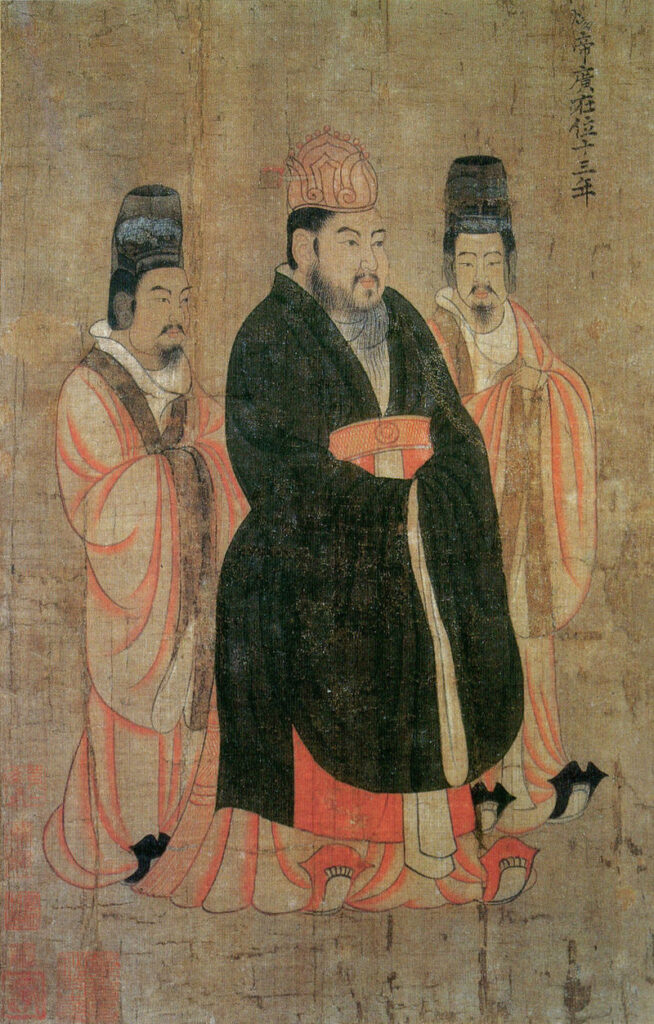
Image Source: Public Domain
About Emperor Yangdi / Mingdi
Reign Years:604-618 A.D
Given Name: Tang Guang
Reign Name:Emperor Yang

Image Source: Public Domain
Reign Years:604-618 A.D
Given Name: Tang Guang
Reign Name:Emperor Yang
Emperor Yang of the Sui Dynasty ruled for 14 years until his death by assassination. Many controversies were associated with him when he assumed the throne. Yang Guang, also known as Emperor Yang (other aliases: Ying, Amo, Emperor Ming), was the second Chinese emperor of the Sui Dynasty.
The Sui Dynasty (581-618 C.E) ruled briefly in China, acknowledging only two emperors, the father and son Emperor Wendi and Emperor Yang, respectively. While Wendi was considered the most suitable emperor of his time, his son Yang was known as one of the worst tyrants in Chinese history.
Yangs era was considered an ambitious one. He tried to continue the legacy his father started by lavishly spending on the construction of infrastructures. He also expanded his and the dynastys influence inside and outside of China. However, history attests that all of these efforts were in vain.
The two Sui Dynasty emperors were incomparable. It was the rise and fall of the Sui dynasty. China probably has seen the two sides of the coin under the Sui Dynasty: its full glory under Emperor Wendi and its darkest times under Emperor Yang.
Go back in time and follow the timeline and emperors of the Sui Dynasty.
Read MoreEmperor Yang was the second son of Emperor Wendi, the first emperor of the Sui Dynasty. Yang was named Yang Ying but was renamed Yang Guang after oracles advised his father to change his name. He had an older brother named Yang Yong, the Crown Prince, representing the aristocrats of the north at the time of their fathers era.
He was considered to be his parents favorite son. Before Chinas unification, he was given the title of the Duke of Yanmen on account of his fathers achievements. Known to be courageous and valiant from a young age, Yang was in charge of five armies in his fathers conquest in the Southern Chen Dynasty.
Before he snatched the crown from his older brother, Emperor Yang became a marshal. He spearheaded in defeating kingdoms in Southern China. As a result of defeating the biggest kingdom in the south, he became the representative of the new landlords. Southerners stopped rebelling and respected the Sui Dynasty.
Since Yang was the favorite son, he was able to convince his parents to strip his older brother from being the crown prince. While its true that the Crown Prince Yang Yong lived extravagantly with vices, Yang Guang was good at pretending to act otherwise. He successfully led Emperor Wendi to name him the Crown Prince and banish his older brother.
As the Crown Prince, he was highly commended by his subjects.
Traditional historians believe that Emperor Yang is one of the worst leaders in Chinese history. Even before his reign, there were already controversies tackling his assertion of the emperorship.
It was widely believed that Yang had killed his own father. Though there were no claims to prove this theory, it was ingrained in the traditional Chinese mindset that Emperor Yang was willing to have someone murdered — whether his older brother, other brothers, nephews — who are essentially a threat to his throne.
Emperor Yang was a patron of the arts. He was considered a talented and gifted artist. His love for music, arts, literature, and education pushed him to open colleges that offered opportunities for his subjects.
However, his relatively evil nature drove him to murder his co-artists, who he considered competitions.
In the hopes of continuing his fathers legacy, several major construction projects were set into place during his reign: larger canals, roads, palaces, and the continuous reconstruction of the Great Wall. However, he was heavily criticized for the death of six million workers.
Emperor Yang attempted to modernize China through construction projects like luxurious palaces and massive food storages. He spent lavishly on these projects that severely affected the royal treasury and the countrys financial resources.
His ruthlessness and extravagant spending frustrated the people. Even more so when he imposed excessive taxes on people to enable corruption within his government.
This magnificent ฺBlue and White Ming vase is perfectly preserved with traditional cobalt oxide blue tones that still glow like the first day. The piece begins with a slim foot that makes way for exquisitely defined arches spread across the base.
Buy Now!The blue glaze of the traditional cobalt oxide of this early Ming Dynasty porcelain jar shines like the first day.Its base with a slim foot opens the way to a double-line medallion that cements the main figure
Buy Now!This elegant blue and white Ming vase was painted exclusively in exquisite blue tones of traditional cobalt oxide has been superbly preserved. Its base begins with elegant floral arches between two double medallions.
Buy Now!Emperor Yang inherited his militaristic talent from his father. He led extensive military campaigns to control more territories and proliferate his influence. He maintained the Chinese empire in Vietnam and explored more territories to conquer. However, these expeditions were at the expense of the depletion of Chinas financial resources.
Join the VIP club, Get Auction notification, special offers and more!
The Chinese emperors misrule sparked major rebellions across the country. 618 rebellious army officers staged a coup and attacked the palace. It was said that Emperor Yang tried deceiving the rebels by attempting suicide by poison, but rebels discovered the scheme. The Sui Dynasty emperor was then strangled by a rebel using his own scarf.
Supporters, high-ranking officials, and relatives were killed along with Emperor Yang. While this coup was staged to defeat Yangs ruthlessness, it was also the beginning of the Sui Dynastys downfall.